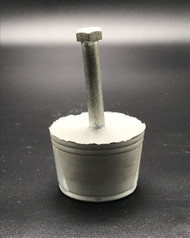Epoxy floors provide an array of different styles, colors, and customizations. However, epoxy floors also vary in thickness, and in most cases, this is overlooked. This is usually because not many people and installers are talking about epoxy floor thickness, so there is little information available about it. Most epoxy companies don’t even give you enough detail about their epoxy product thickness and how it affects your floor.
Some epoxy floors are engineered to be more resilient than others. Your workspace or residential needs should influence the thickness of your epoxy floor. In this regard, we are going to be discussing some factors that will help you understand your epoxy flooring thickness. Floor coatings are measured in ‘mils’ (a mil is 1/1000th of an inch). For example, one-eight of an inch equals 125 mils. Standard ‘home center’ floor paint when cured is about 2 mils. A sheet of standard copy paper is about 4 mils.
Thin Floor Coating
The thickness of these floors varies from 3-10 mils based on the number of times it is coated, and if a top coat is used. These are perfect for floors that get standard foot traffic and lighter vehicle traffic. Primarily, they are only used to keep the surface of the floor shiny and clean.
High Build Floor Coatings
These floors are often self-leveling and run about 10+mils thick. For some industries, even a 20mm thick coating is not sufficient due to the use of heavy machinery, vehicles, forklifts, and movement of loads. In this case, the thickness may go as high as 250 mils (¼”) and even up to ½” (500 mils). They use various layers of intermediate aggregates and screeds to build up these types of floors, and they are very expensive.
The general rule of thumb is the thicker the floor, the longer lasting, and the more expensive. One thing to remember is that if you go from a 10 mil floor thickness to a 20 mil, you need TWICE as much material and cost.
Is it an industrial-grade?
Most people find it difficult to know if their epoxy coating is industrial grade. Well, the simple way to find out is to check the abrasion rating. With this, you’d understand how the epoxy floor responds to foot and vehicle traffic. This lets you know how long the epoxy coating can endure stains and pressure without losing its gloss.
Abrasion is tested used abrasion meters which test a sample for wear. The more ‘loss’ the sample has the less abrasion resistant it is. If the abrasion rating is high, then this means that the epoxy coating will wear out quickly. If the loss is low, then it is high abrasion-resistant. Note that every small variation in the abrasion rating can make a large difference in wear factor. vary from 4mg, 8mg, and 20mg to 24 mg. A floor with an abrasion loss rating of 24mg is not thick enough and could wear out quickly..
High Solids Epoxies
Epoxy floor thickness is also affected by the budget you have for your project. An example of such an epoxy is the Armorpoxy II high solids epoxy, which utilizes a topcoat with a nonskid wear additive called UltraWear. The two-layer feature helps to keep costs to a minimum.
Benefits of Understanding Epoxy Flooring Thickness
- Informed Decision-Making: Understanding the various thicknesses of epoxy flooring enables you to choose the right product for your specific needs, whether for residential or industrial applications.
- Durability and Longevity: Thicker epoxy coatings (10 mils or more) are generally more durable and can withstand higher traffic loads, making them ideal for industrial settings where heavy machinery is used. A thicker floor can significantly extend the lifespan of your flooring investment.
- Cost-Effectiveness: While thicker epoxy options may come with a higher upfront cost, they can save you money in the long run by reducing the need for frequent replacements or repairs. Understanding thickness helps you calculate the material and installation costs accurately.
- Resistance to Wear and Tear: Knowing the abrasion ratings associated with different thicknesses allows you to select a coating that meets your needs for durability against stains and mechanical stress. A high abrasion resistance rating ensures that your floor will maintain its appearance and functionality longer.
- Customization Options: Epoxy flooring is available in various thicknesses, colors, and styles. Understanding the differences helps you customize your floor to match your aesthetic and functional requirements.
- Increased Performance Features: Higher solid epoxies and 100% solid systems offer superior performance in demanding environments. Understanding the characteristics of these products can help you choose coatings that feature additional benefits like non-slip properties and resistance to chemicals.
However, some epoxies are 100% solids systems which means that nothing evaporates out of the 100% solids epoxy. ArmorUltra is an example of this system. These floors are extremely durable, and ideal for commercial/industrial environments. Our www.armorcladepoxy.com is also a 100% solids system designed for garage floors. It is more costly, but ideal for more demanding environments.
Now that you have an idea of epoxy flooring thickness and types, we are confident that you will ask the right questions and make a better buying decision. You can contact us to share your epoxy flooring needs and concerns. We are always happy to help.
